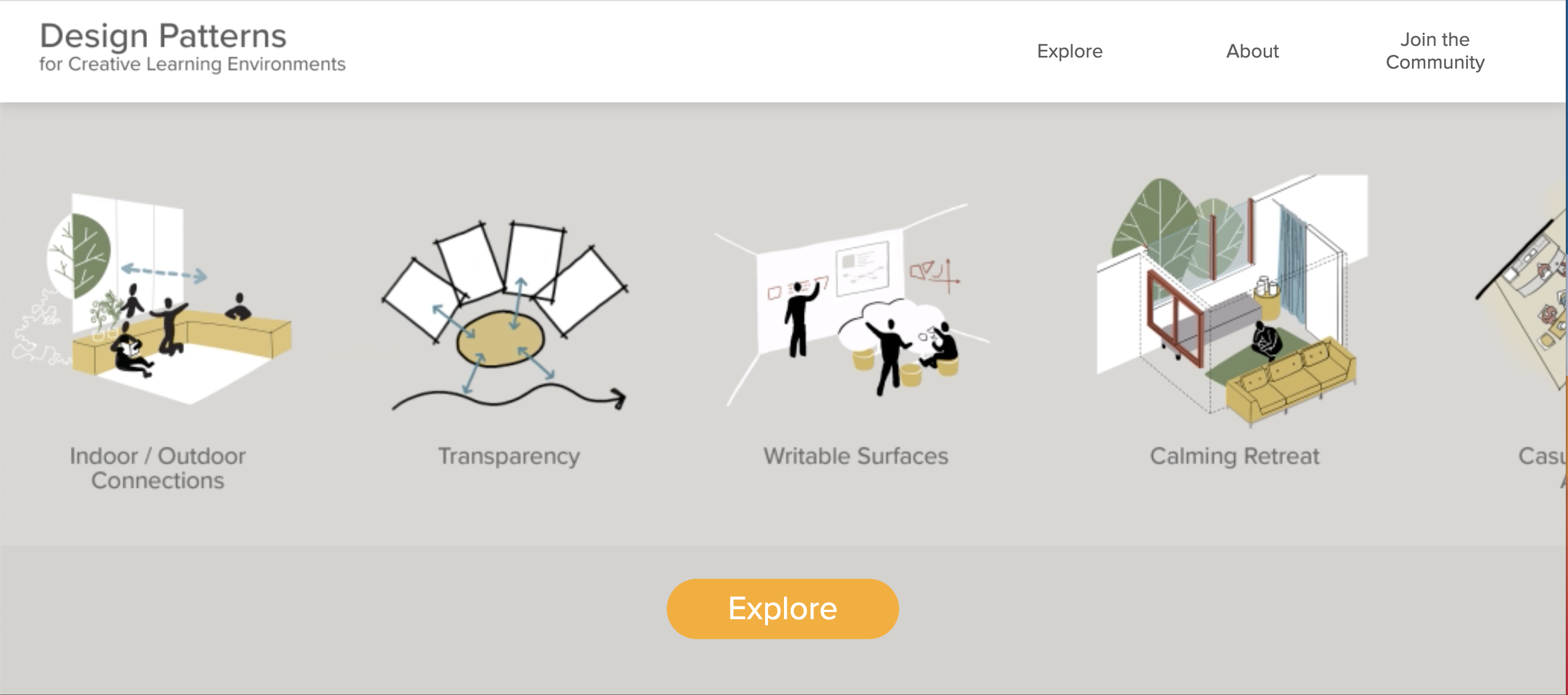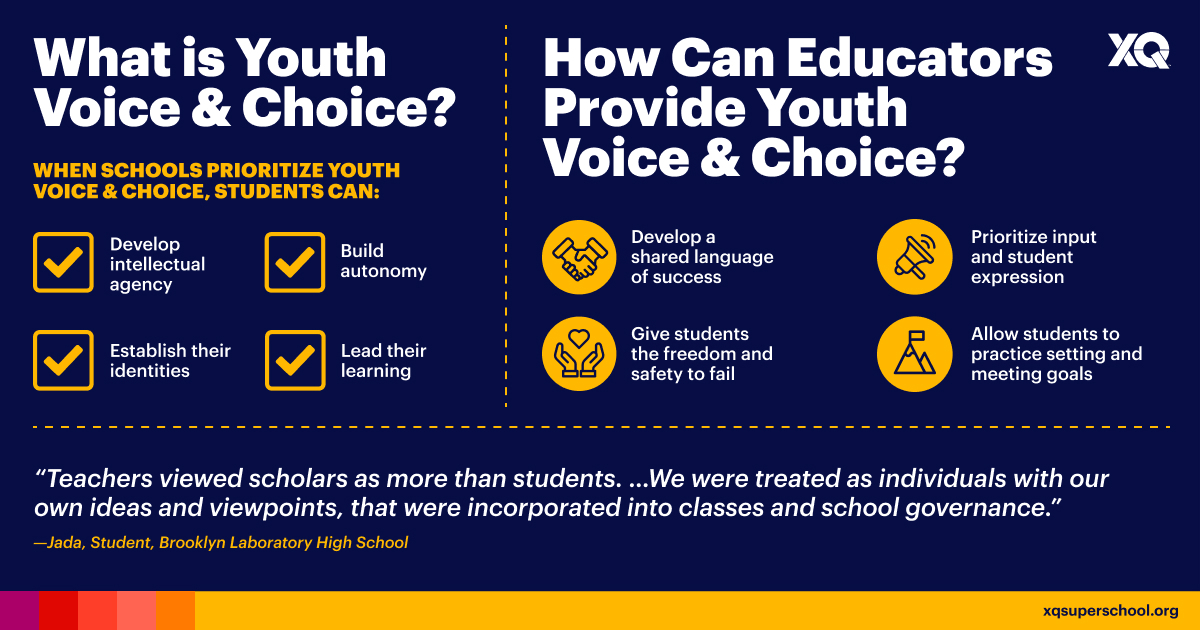Transformational schools do what might seem courageous to some: they give students an active voice in their learning and the power to shape it. This commitment to youth voice and choice is so significant that it is one of the six XQ Design Principles. These principles are at the heart of every XQ school, though how each school manifests the principles varies in large ways and small.
To help your school discover its growth trajectory of its own, let’s explore what it means to embrace youth voice and choice.
What Is Youth Choice and Voice?
Bringing youth voice and choice to life in your school is not a simple one-off. It’s a holistic approach to teaching, learning, and school culture that focuses on giving all students opportunities to bring their identities as learners and develop the capacity for agency and autonomy.
[
Principles in Practice: Start making change today with the XQ Design Principles rubric.
]
“Adolescence is a time of great discovery. In high school, young people are figuring out who they are and who they want to be,” explains Lauren Bierbaum, XQ’s former head of data, research, and evaluation. “As they explore new areas of knowledge and build new skills, the opportunity to define their own passions and inform their own learning journeys is critical to achieving the kinds of learner outcomes most valued by colleges, employers, and a 21st century society.”
“Teachers viewed scholars as more than students. … We were treated as individuals with our own ideas and viewpoints that were incorporated into classes and school governance. Brooklyn Lab gave me the strength to use my voice. Now, I’m not afraid to stand up and speak my opinion.”
Jada, Student, Brooklyn Laboratory High School
In fact, bringing youth voice and choice to your school includes engaging with the Instructional Core, an approach to education defined by Richard Elmore. This approach to education argues that student achievement and learning is improved when students take a larger role in their own learning and in the instructional process. In other words, as students become leaders of their own education—utilizing their student voice and choice—they flourish. Learning environments that honor student voice and choice help students develop since these environments empower students and make adults champions of student voice.
- Empower students: Youth voice and choice requires learning experiences that allow learners to personalize their path toward postsecondary goals. Setting up space where learners are comfortable taking risks, making mistakes—and learning from them—and applying that learning across myriad contexts. Students need to engage in rigorous and relevant work and have high expectations for themselves. When creating a learning environment that centers youth voice, educators make it safe for learners to articulate what they need and to develop the agency to act on it and so empower students.
- Adults as champions: All adults in the community recognize that their role is to foster student agency. They value young people’s individual journeys and facilitate individualized goal-setting, aspiration-building, and learning processes aligned with learners’ goals and passions. Personal growth is celebrated by all members of the community, and the whole school consistently engages in public recognition of individual journeys.

How Can Educators Ensure Students Have Voice and Choice?
- Involve students in decisions that affect them. The PAACC framework can help you work with students to co-create their learning experience based on their interests, goals, and creativity.
- Student choice needs rigorous inquiry. You might worry that a student-led teaching and learning environment could sacrifice high academic standards. But that needn’t be the case. Instead, use the curricula to connect students’ interests with skills that prepare them for college and their desired careers. This approach doesn’t lead to a less challenging learning environment. It just ties challenging school subjects more directly to students’ real-world passions.
- Prioritize relationship building. Is there structured time for students to check in with a caring adult during the day? By ensuring that at least one adult has a positive relationship with a student, students are more likely to have academic success, reduced absenteeism, increased motivation and engagement, and reduced emotional distress.
What Does Youth Voice and Choice Look Like in Action?
“We’re trying to meet the students where they’re at, building projects based on their passions. The mentorship piece really sticks with the students because it gives them a chance to see what it’s like firsthand from a professional.”
Nick Greco, Teacher, Tiger Ventures
XQ schools find many ways to amplify student voice and give learners ample space to make choices. Take a look!
Brooklyn Laboratory High School, in New York, engages student agency through classroom debates centered around public health and informed decision-making, made possible through a partnership with an organization called Argument Centered Education (ACE).
Students at Purdue Polytechnic High School in Indianapolis, Indiana, engaged in an interest-based passion project, reflecting on their personal experiences in life at school and home during the COVID-19 pandemic through poetry, which they published in a book entitled “Finding Our Voices.”
New Harmony High students, in New Orleans, Louisiana, learned about the Harlem Renaissance and hip hop—two major art movements—by converting a Harlem Renaissance poem into a hip hop song. They compared messaging and created album covers to communicate the connections between the works.
With support from their principal Eric Collazo, Washington Leadership Academy students in Washington D.C. responded to racial injustice in their community with a Rock The Vote 2020 Town Hall—more than 120 attendees joined short student-led sessions on voter suppression, issue-based voting, and registering to vote and engaging their families.
How Can Educators Provide Youth Voice and Choice?
“At our school, I get to be myself. We have a lot of freedom here. We can explore without getting judged. Here, you can be anyone you want to be. I want to be myself. I want to be a leader, not a follower. I want to be my own person.”
Kya, Student, Latitude High
Here are some tips for how to bring youth voice and choice into your classroom.
- Develop a shared language of success. Work alongside every student to describe short-term and long-term goals to help them develop a roadmap to accomplish them. That could mean having meetings with each student or the whole class at the beginning of the school year or at the beginning of large projects to help them articulate success in their own words.
- Keep a safe distance. Give students the freedom to fail as they build capacity for agency and autonomy, but also be close enough to provide a safety net and confidence to fail forward.
- Prioritize input. Give opportunities for students to voice their thoughts, and express themselves in writing and speaking. In some cases, students may need an extra nudge. Don’t be afraid to suggest topics, projects, and causes for a student to explore in their next assignment.
- Practice makes growth. Provide flexible learning opportunities for students to practice setting and meeting their goals. Remember: choice by itself is not effective unless students develop the “capacity to choose” what best meets their personal learning needs and goals.This approach can look like meeting with students to determine their weekly goals and individual to do’s, or encouraging students to check-in with each other and reflect at the end of the week on what helps and limits their productivity and growth.

Learn more.
Explore the other XQ Design Principles.
Meet the XQ Schools.
Sign up for XQ Xtra, our biweekly newsletter for educators ready to rethink high school.